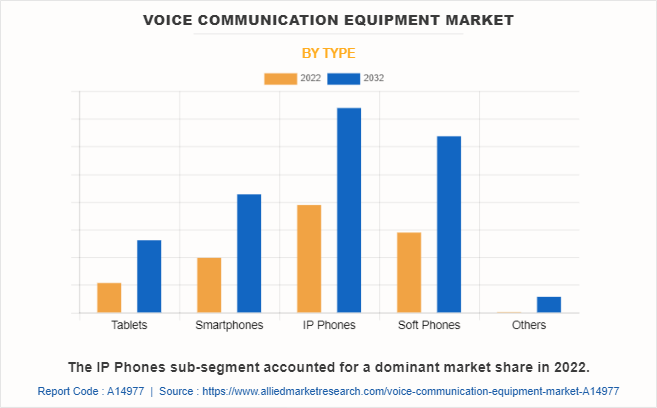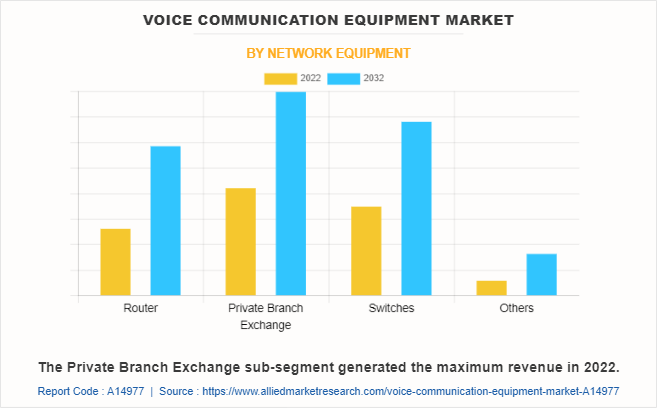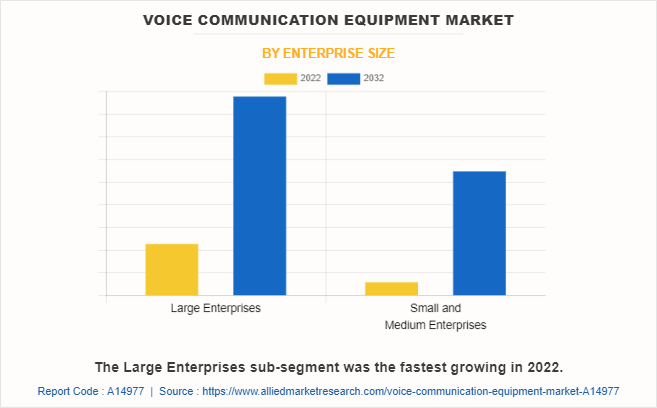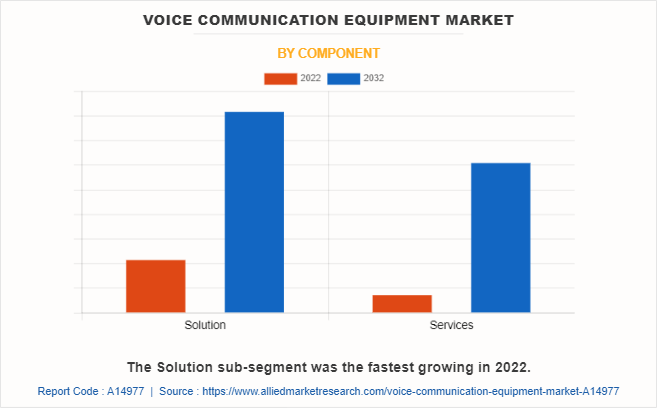Voice Communication Equipment Market Insight: 2032
The global voice communication equipment market size was valued at $7.4 billion in 2022, and is projected to reach $13.1 billion by 2032, growing at a CAGR of 6% from 2023 to 2032.
Voice communication equipment refers to devices or systems used to transmit and receive audio signals for the purpose of human communication. It encompasses a wide range of devices and technologies that enable people to communicate verbally over short or long distances. This equipment is designed to capture, process, transmit, and reproduce voice signals, allowing individuals to interact and exchange information in real-time.

The increasing demand for Unified Communication and Collaboration (UC&C) solutions is expected to drive the growth of the voice communication equipment market. Organizations are recognizing the importance of effective communication and collaboration to streamline operations and improve productivity. UC&C solutions provide integrated platforms that bring together various communication channels, including voice, video, messaging, and file sharing. Voice communication equipment, such as IP phones and conference systems, enable real-time communication and collaboration among employees, partners, and customers, regardless of their physical location. Moreover, the rise of remote work and distributed teams has necessitated robust communication and collaboration tools. Voice communication equipment enables employees to connect seamlessly with each other, regardless of their geographical location. With features like video conferencing, screen sharing, and instant messaging, these devices facilitate virtual meetings and teamwork, promoting effective collaboration.
Furthermore, UC&C solutions offer cost savings for organizations by consolidating multiple communication systems into a unified platform. Voice communication equipment, such as IP phones, leverages Internet protocol (IP) technology to transmit voice over data networks, eliminating the need for separate telephone lines. This reduces infrastructure costs and ongoing maintenance expenses associated with traditional phone systems.
Voice communication equipment that lacks robust authentication and access control mechanisms can be susceptible to unauthorized access. If malicious users gain unauthorized entry to the system, they can potentially manipulate or disrupt voice communications, compromising the integrity and confidentiality of conversations. Moreover, modern voice communication systems often rely on digital technologies and interconnected networks. This interconnectivity exposes them to the risk of data breaches, where sensitive information, including voice recordings and call logs, can be accessed and exploited by unauthorized individuals. Organizations are cautious about protecting their sensitive data and complying with data protection regulations, which can hinder their adoption of voice communication equipment. Furthermore, voice communication systems can be vulnerable to malware and phishing attacks. Malicious software can infect the system and compromising its integrity and the security of voice data. Phishing attacks can target users and tricking them into revealing sensitive information or gaining unauthorized access to their accounts, further compromising the security of voice communications.
There is a growing need for voice communication equipment that can seamlessly integrate with unified communications (UC) platforms owing to the increasing adoption of UC solutions in enterprises. As more businesses embrace UC solutions like Microsoft Teams, Slack, or Cisco Webex, there is a growing need for voice communication equipment that can seamlessly integrate with these platforms. Companies that can offer compatible equipment, such as IP phones, headsets, conference room systems, or audio peripherals, have the opportunity to capture a significant market share. Moreover, voice communication equipment that goes beyond basic calling capabilities and offers advanced collaboration features aligning with UC platforms can be highly sought after. Features like call recording, voicemail transcription, presence indication, or integration with collaboration tools like file sharing or video conferencing can provide added value to businesses and improve productivity.
Moreover, with the rise of remote work and mobile workforce, there is a growing demand for voice communication equipment that supports mobility and remote connectivity. Devices that enable seamless communication across different locations, integrate with mobile devices or offer softphone applications can cater to the needs of distributed teams and remote workers. Enterprises often require scalable and flexible communication solutions to accommodate their evolving needs. These major factors that are projected to offer growth opportunities for market players during the forecast period.
The key players profiled in voice communication equipment market forecast report include ADTRAN, Inc., MDS Gateways, Samsung, Electronics Co Ltd, Speedflow Communications, Apple, Inc., Microsoft Corporation, 8x8, Inc., Siemens Enterprise Communication, PanTerra Networks, and IBM Corporation. Investment and agreement are common strategies followed by major market players. For instance, in February 2022, Stryker, the U.S.-based multinational medical technology company announced that it had completed the previously announced acquisition of Vocera Communications, Inc. a leader in digital care coordination and communication.
The voice communication equipment market is segmented on the basis of type, network equipment, enterprise size, industry verticals, component, and region. By type, the market is divided into tablets, smartphones, IP phones, soft phones, and others. By network equipment, the market is classified into router, private branch exchange, switches, and others. By enterprise size, the market is classified into large enterprises and small & medium enterprises. By industry vertical, the market is classified into BFSI, healthcare, hospitality, retail, transportation & logistics, IT & telecom, and others. By component, the market is classified into solution and services. By region, the market is analyzed across North America, Europe, Asia-Pacific, and LAMEA.
The voice communication equipment market is segmented into Type, Network Equipment, Enterprise Size, Industry Verticals and Component.

By type, the IP phones sub-segment accounted for a dominant market share in 2022. An IP phone, also known as an Internet Protocol phone or VoIP phone, is a telephone device that transmits voice calls via the internet rather than traditional telephone lines. When compared to traditional phone systems, IP phones often offer lower long-distance and international call charges. There is no need for separate phone and data networks because they use the Internet for transmission. These are predicted to be the major factors boosting the voice communication equipment market growth.

By network equipment, the private branch exchange sub-segment dominated the global voice communication equipment market share in 2022. A private branch exchange (PBX) is an enterprise telephone system that transfers calls between users on local lines while allowing all users to share a limited number of external phone lines. In contrast to a public switched telephone network, the primary objective of a PBX is to eliminate the need for each user to have a line to the telephone company's central office. A PBX enables businesses to operate an internal telephone system while using fewer phone lines from telephone companies. The PBX system provides the option of monitoring voice messages and recorded messages. It includes phone enhancements for everyone in the corporation. PBX has updated the business calling process, which is a significant improvement over the previous generation voice communication equipment.

By enterprise size, the large enterprises sub-segment dominated the global voice communication equipment market share in 2022. The market for voice communication equipment is highly competitive, with a diverse set of competitors operating in a variety of categories. As several large enterprises move their operations to the cloud, there is a growing demand for voice communication technology that provides seamless collaboration across numerous platforms and devices while also being easily connected with existing systems. Furthermore, large organizations are driving the digital transformation of workspaces and field operations, with the goal of improving overall operational efficiency and increasing employee engagement. These factors are boosting the demand for sophisticated voice communication equipment that can successfully support the demand of large enterprises'.

By industry vertical, the IT & telecom sub-segment dominated the global voice communication equipment market share in 2022. There is an increasing demand for voice communication equipment that can assist enterprises as they continue to rely on technology to conduct their operations. This trend is being led by the IT and telecom industries, which require dependable communication technologies to run their operations. Cloud-based voice communication devices, such as softphones and IP phones, enable greater flexibility, scalability, and cost-effectiveness than traditional on-premises systems, leading to their increasing popularity in recent years.

By component, the solution sub-segment dominated the global voice communication equipment market share in 2022. Companies in a wide range of industries are looking for comprehensive communication solutions that go beyond the typical hardware-centric approach. These solutions include a variety of technologies, software, and services that enable smooth and effective voice communication. The increase in demand for cloud-based and software-defined communication systems has contributed to the solution sub-segment's dominance. These solutions provide greater flexibility, scalability, and cost-effectiveness, enabling enterprises to respond to changing communication requirements.

By region, North America dominated the global market in 2022. The voice communication equipment industry in North America is undergoing rapid expansion and innovation. Businesses are progressively investing in voice communication equipment to improve their communication skills as modern communication technologies become more widely adopted. This market includes a diverse set of solutions such as IP phones, conference phones, PBX systems, and unified communication platforms. The increasing demand for seamless and effective communication is one of the primary reasons driving the growth of the voice communication equipment market in North America.
Impact of COVID-19 on the ndustry
- The COVID-19 pandemic has had a significant impact on the voice communication equipment market. The pandemic led to disruptions in global supply chains, manufacturing operations, and logistics. This affected the production and distribution of voice communication equipment. Companies faced challenges in procuring raw materials and components, and maintaining normal operations.
- As many organizations adopted remote work policies to ensure business continuity, the demand for voice communication equipment such as headsets, microphones, and speakerphones increased. Companies and individuals required reliable audio solutions for remote meetings, conferences, and virtual collaboration.
- The pandemic accelerated the adoption of cloud-based communication solutions. Many organizations switched from traditional on-premises communication systems to cloud-based platforms. This shift impacted the demand for specific types of voice communication equipment, favoring software-based solutions over hardware.
- With lockdowns, travel restrictions, and work-from-home policies implemented in response to the pandemic, the demand for voice communication equipment that enables remote communication surged. Businesses and individuals relied heavily on video conferencing, virtual meetings, and other remote communication tools to stay connected. This led to a greater need for devices such as headsets, microphones, webcams, and other accessories.
Key Benefits for Stakeholders
- This report provides a quantitative analysis of the market segments, current trends, estimations, and dynamics of the voice communication equipment market analysis from 2022 to 2032 to identify the prevailing voice communication equipment market opportunities.
- The market research is offered along with information related to key drivers, restraints, and opportunities.
- Porter's five forces analysis highlights the potency of buyers and suppliers to enable stakeholders make profit-oriented business decisions and strengthen their supplier-buyer network.
- In-depth analysis of the voice communication equipment market segmentation assists to determine the prevailing market opportunities.
- Major countries in each region are mapped according to their revenue contribution to the global market.
- Market player positioning facilitates benchmarking and provides a clear understanding of the present position of the market players.
- The report includes the analysis of the regional as well as global voice communication equipment market trends, key players, market segments, application areas, and market growth strategies.
Voice Communication Equipment Market Report Highlights
| Aspects | Details |
| Market Size By 2032 | USD 13.1 billion |
| Growth Rate | CAGR of 6% |
| Forecast period | 2022 - 2032 |
| Report Pages | 290 |
| By Type |
|
| By Network Equipment |
|
| By Enterprise Size |
|
| By Industry Verticals |
|
| By Component |
|
| By Region |
|
| Key Market Players | IBM Corporation, MDS Gateways,, Speedflow Communications, PanTerra Networks, ADTRAN, Inc., Siemens Enterprise Communication, 8x8, Inc., Apple, Inc., Samsung Electronics Co Ltd, Microsoft Corporation |
The rise of remote work, distributed teams, and global connectivity has boosted the demand for voice communication equipment solutions. Voice communication equipment plays a vital role in facilitating seamless communication and collaboration across various channels, such as Voice over Internet Protocol (VoIP) systems, IP phones, and conference systems, which is estimated to generate excellent opportunities in the voice communication equipment.
The major growth strategies adopted by voice communication equipment market players are investment and agreement.
Asia-Pacific is projected to provide more business opportunities for the global voice communication equipment market in the future.
ADTRAN, Inc., MDS Gateways, Samsung, Electronics Co Ltd, Speedflow Communications, Apple, Inc., Microsoft Corporation, 8x8, Inc., Siemens Enterprise Communication, PanTerra Networks, and IBM Corporation are the major players in the voice communication equipment market.
The IT & telecom sub-segment of the industrial verticals acquired the maximum share of the global voice communication equipment market in 2022.
BFSI and IT & telecom industries are the major customers in the global voice communication equipment market.
The report provides an extensive qualitative and quantitative analysis of the current trends and future estimations of the global voice communication equipment market from 2022 to 2032 to determine the prevailing opportunities.
Cloud-based voice communication solutions offer scalability, flexibility, and cost-efficiency to businesses. Organizations are increasingly adopting cloud-based voice communication equipment to leverage advanced features, such as virtual phone systems, call routing, and integration with other cloud applications, which is estimated to drive the adoption of communication software.
Loading Table Of Content...
Loading Research Methodology...



